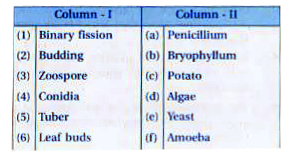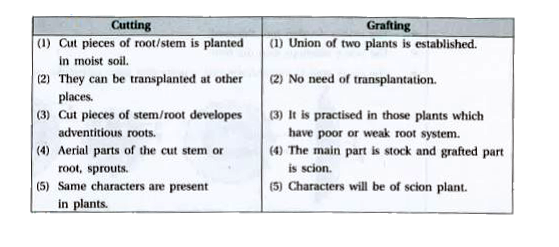Cutting and Grafting. Solution in Gujrati
Topper's Solved these Questions
- REPRODUCTION IN ORGANISMSBOOK - KUMAR PRAKASHANCHAPTER - REPRODUCTION IN ORGANISMSEXERCISE - SECTION - C OBJECTIVE QUESTIONS - ANSWERS (Match the columns)
4 Videos
- REPRODUCTION IN ORGANISMSBOOK - KUMAR PRAKASHANCHAPTER - REPRODUCTION IN ORGANISMSEXERCISE - SECTION - C OBJECTIVE QUESTIONS - ANSWERS (Definitions / Explanation)
13 Videos
- REPRODUCTION IN ORGANISMSBOOK - KUMAR PRAKASHANCHAPTER - REPRODUCTION IN ORGANISMSEXERCISE - SECTION - F MULTIPLE CHOICE QUESTIONS (MCQs)
139 Videos
- PRINCIPLES OF INHERITANCE AND VARIATION BOOK - KUMAR PRAKASHANCHAPTER - PRINCIPLES OF INHERITANCE AND VARIATION EXERCISE - SECTION -F (MULTIPLE CHOICE QUESTIONS (MCQS)) (MCQs ASKED IN COMPETITIVE EXAM)
38 Videos
- REPRODUCTIVE HEALTH BOOK - KUMAR PRAKASHANCHAPTER - REPRODUCTIVE HEALTH EXERCISE - Section - F Multiple Choice Questions (MCQs)
102 Videos
Similar Questions


View SolutionReproduction
View SolutionWhich of the following processes results in the formation of clone of bacteria ?
(A) Transformation (B) Transduction (C) Binary fission (D) Conjugation
View SolutionThe incorrect statement with regard to haemophilia is
View SolutionWhich problems arise due to uncontrolled population growth ?
View SolutionThe cut part of stem (having roots and fixed to ground ) which is used in the process of grafting is known as :
View SolutionXenograft is a graft
View SolutionGrafting is found in
View Solutionग्राफिटंग के समय काटकर लाए गए भाग को ............तथा स्थापित भाग को….....कहते हैं।
View SolutionWhat is grafting? Describe about the different techniques of grafting.
View Solutionग्राफ्टिंग किसे कहते हैं ? पौधों में ग्राफ्टिंग की क्रियाविधि लिखिये।
View SolutionTongue grafting Wedge grafting Mound layering Crown grafting
View SolutionHow tongue grafting differs from wedge grafting ?
View SolutionIn grafting, the portion to be grafted on the main part is called :
View SolutionMango and guava plants are propagated through
(A) Stem cutting
(B) Layering
(C) Grafting
(D) Tissue culture
View Solution

